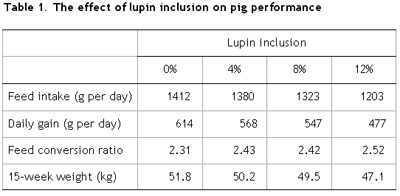AFBI study the use of lupins in diets for pigs

Soyabean meal is the main source of protein in diets for pigs and poultry due to its high crude protein content and its good profile of amino acids. However, as soyabean meal must be imported, home grown protein sources such as lupins have been considered as alternatives.
Lupins can contain up to 44% crude protein and previous research elsewhere has shown they can be included in pig and poultry diets with no adverse effects on performance provided the diets are supplemented with expensive synthetic amino acids.©There is a lack of information on the use of low levels of lupins in pig and poultry diets as a direct substitution for soyabean meal, without additional amino acid supplementation.©The aims of studies conducted at AFBI, Hillsborough and Newforge and funded by DARD were to investigate the effect of substitution of a proportion of soyabean meal with lupins on pig and poultry performance.
©
The effect of lupins on pig performance
Four diets were produced to contain 0, 4, 8 and 12% lupins and offered to a total of 240 pigs in pens of 10 from 10 to 15 weeks of age.©
©
Feed intake and average daily gain decreased with increasing lupin inclusion (Table 1) with the result that pigs offered the 12% lupin diet were 4.7 kg lighter at 15 weeks of age.©Feed conversion ratio (FCR) tended to increase as the level of lupin inclusion increased, although the differences were not significant.©Thus, the reduction in daily gain and live weight at 15 weeks with increasing lupin inclusion may be attributed to reduced feed intake, most likely caused by low levels of alkaloids in the lupins which impacted on palatability.
©
©
©
©
The effect of lupins on broiler performance
Three diets were produced to contain 0, 3 or 6% lupins and offered to 300 broilers in pens of 20 from 0-35 days of age to determine performance.©Apparent metabolizable energy (AME) was determined in a separate trial using 60 broilers and collecting excreta from 14 to 21 days.©There was no difference in diet AME content but lupin inclusion reduced feed intake, daily gain, feed conversion efficiency and final live weight at 35 days
(Table 2).
(Table 2).
©
Again the reduction in performance can be attributed to reduced feed intake of the diets containing lupin.
©
In conclusion, lupin inclusion reduced feed intake and growth rate in pigs and poultry and there is limited potential for lupins to be used as an alternative protein source.
©
©
©











